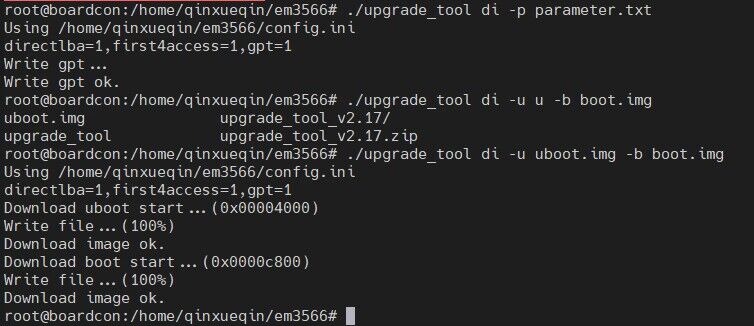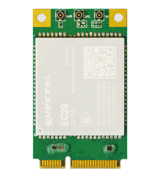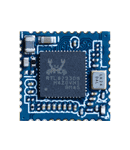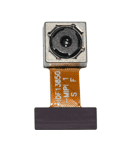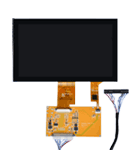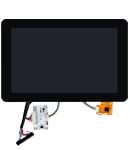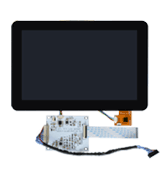Replace logo.bmp and logo_kernel.bmp in the source directory …/kernel, then recompile.
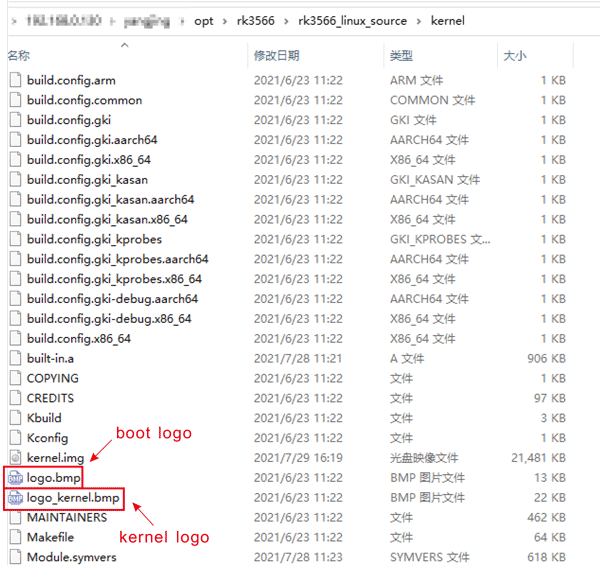
Products
- -Single board computer
- -Rockchip
- SBC3588 Idea3588 Idea3588S Idea3576 SBC3576 EM3576 SBC3568 EM3568 EM3568-AV CAM SBC3566 EM3566 EM3562 EM3326S Idea1126 EM1126 SBC3399 Idea3399 EM3399 Idea3288 EM3288 EM1808 EM3128 EM1103B SBC1108
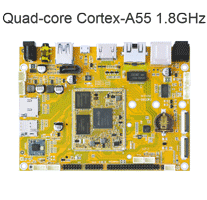
* Processor: Rockchip RK3566. Quad-core Cortex-A55, 1.8GHz
* NPU: 1 TOPS
* RAM: 2GB
* Storage: 8GB
* Interfaces: 2x UART, Debug, RS485, USB3.0 Host, 4x USB2.0 Host, USB2.0 OTG, Gigabit Ethernet, HDMI, MIPI DSI/LVDS, eDP, MIPI CSI, ADC, GPIO, SD, IR, MEMS, etc.
* Operating system: Android 14, Debian 12, Buildroot
* Dimensions: 135 x 95 mm
* Expansion Module: 4G model, WiFi, Camera, 7-inch LCD, 10.1-inch LCD
![]() EM3566 Manual
EM3566 Manual
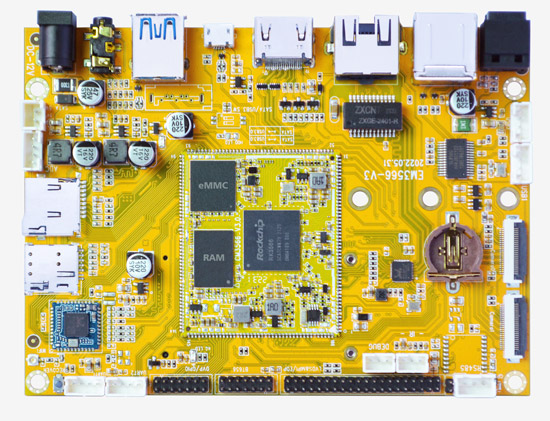
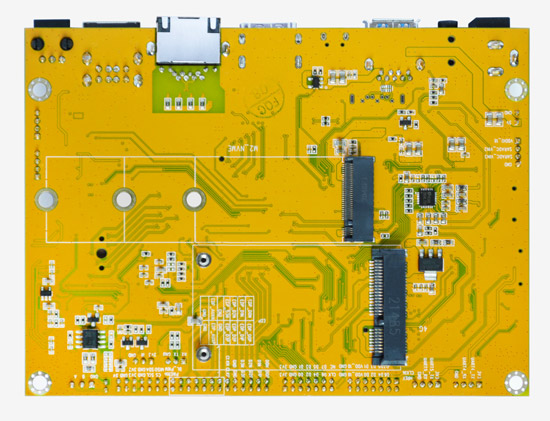
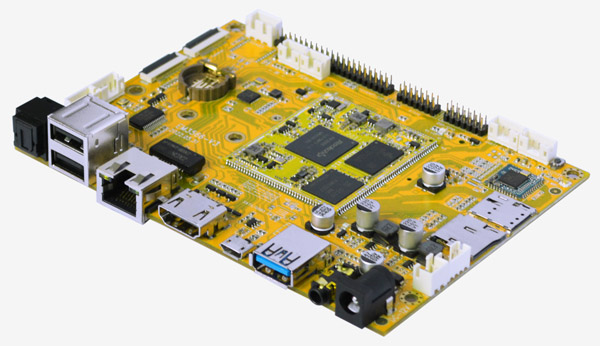
EM3566 gives full play to the extreme performance and rich interfaces of the RK3566 SOC
EM3566's key features including a Rockchip RK3566 high-performance and low power 64-bit quad-core processor, HDMI display support at resolutions up to 4KP60, hardware video decode at up to 4KP60, hardware video encode at up to 1080P60, up to 8GB LPDDR, 128MB EMMC. Also offers Gigabit Ethernet port, as well as M.2 socket which enables expansion with a large hard drive and plus a miniPCIe, a Nano SIM card socket for 4G cellular connectivity. Display and camera capabilities with graphics and video hardware acceleration.
NPU supports one-click switching of mainstream architecture models such as Caffe/TensorFlow.
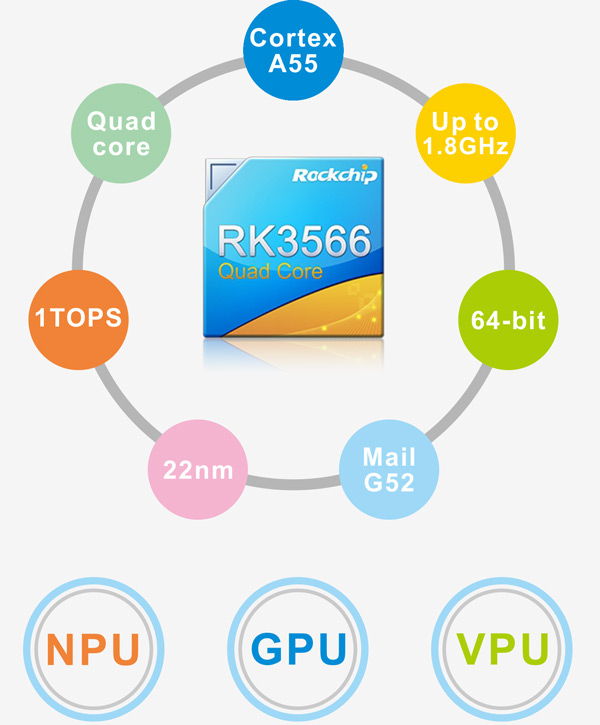
Open system architecture design, provide fast and professional service
It supports mature, stable, and highly extensible Android, Debian, Buildroot, QT systems and provides a complete set of software system customization service, including system kernel modification, driver migration, application development, and UI customization for customers' personalized and diversified customization requirements. Provide a safe and stable system environment for terminal product research and development.

Provide comprehensive, accurate and complete user manuals
It can provide complete technical datasheet including baseboard reference Design user manual ever the PCB file for your separate application. Source code, Hardware user manual, Software user manual, API interface and SDK development tools, all in one USB disk. Making the secondary development more easy, convenient and efficient, and helping customers get products to market quickly.

Application Scenario
Electronic Paper
RK3566's advantages in ultra-low power consumption, TCON, handwriting delay, performance, and operating system will become a new driving force for the e-paper application market.
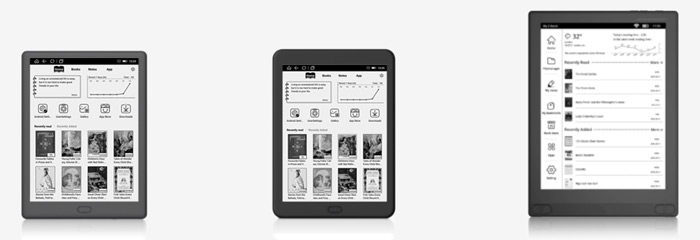
1. Ultra-low power consumption, RK3566 improves performance
Compared with electronic products using LCD and other screens, the use of electronic paper display has a huge advantage of lower power consumption and longer battery life. Compared with the power consumption of several popular 6-inch and 10.3-inch e-book products on the market, it can be found that the products equipped with RK3566 consume less power and perform better.
With RK3566 as the main control of the 6-inch, equipped with Android 11, resolution 1024*758 e-books, sleep power consumption is less than 1mA, 15s page turning on power consumption is less than 30mA, 1s page turning on is about 130mA, static interface power consumption is less than 10mA, than the standby interface power consumption of similar products is reduced by 70%.
10.3-inch large screen equipped with RK3566, Android 11 system, resolution 1872*1404, e-book with stylus, sleep power consumption is only about 1.2mA, static interface power consumption is less than 15mA, 15s page turning on power consumption is less than 50mA, 1s page turning is about 180mA, continuous handwriting power consumption is about 280mA Handwriting power consumption is nearly 40% lower than that of similar handwritten ebooks.
In order to reduce power consumption, for the electronic paper application products, the RK3566 solution has been deeply optimized in the display architecture, system task management, hardware design and other aspects. Among them, using LPDDR4X particles, the power consumption of the VCC_DDR part can be saved by 40%. In addition, RK3566 supports Touch Panel Low Power Mode, which reduces power consumption.
2. Cost optimization, RK3566 comes with TCON interface
RK3566 comes with TCON-EBC, terminal partners do not need to add additional electronic paper display, the cost is greatly reduced. At the same time, the largest resolution supports 13.3-inch 2200*1650, and the pain point demands of large-screen e-paper applications, can support local refresh and global refresh, better deal with residual image and poor clarity and other problems, bring a better visual experience.
3. Handwriting delay is reduced, RK3566 self-developed hardware acceleration module
RK3566 is based on the self-developed hardware acceleration module, which reduces the handwriting delay rate, improves the handwriting speed by 20%, and provides smooth writing and better visual experience.
4. Enable rich AI applications, RK built-in powerful NPU
The built-in NPU of RK3566 enables rich AI applications for products, including intelligent text recognition/word search, OCR note extract, OCR word search, shot question search, comic automatic segmentation and scaling of selected areas.
5. Optimized system consumption, RK supports lightweight Android/OS
RK3566 supports the most lightweight Android/Linux OS for e-paper applications, optimizes task scheduling, reduces system CPU consumption, reduces memory usage, improves system fluency, and ensures application compatibility.
Fitness mirror and smart screen designed for fitness users
Use RK3566 landing fitness mirror and fitness smart screen application to create better fitness equipment for fitness users and provide high-quality fitness experience. The RK3566 has a built-in independent NPU that makes it easy to implement AI coaching functions. This means that our fitness goggles and fitness smart screens can not only record the user's fitness data.
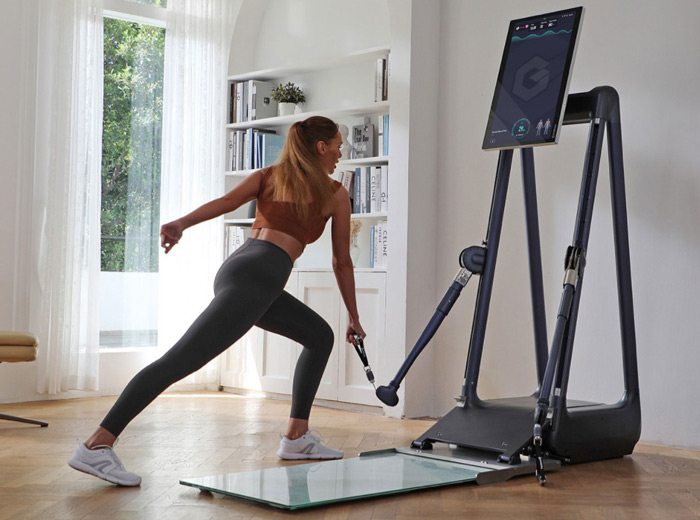
It can also provide you with personalized fitness trainer advice.
At the same time, RK3566 specific high-performance hardware features, can support 4K@60FPS video decoding output and up to 1080P@100FPS hardware coding capabilities.
This is where our devices can provide sufficient performance support for instructional interactions while providing an extremely high visual experience.
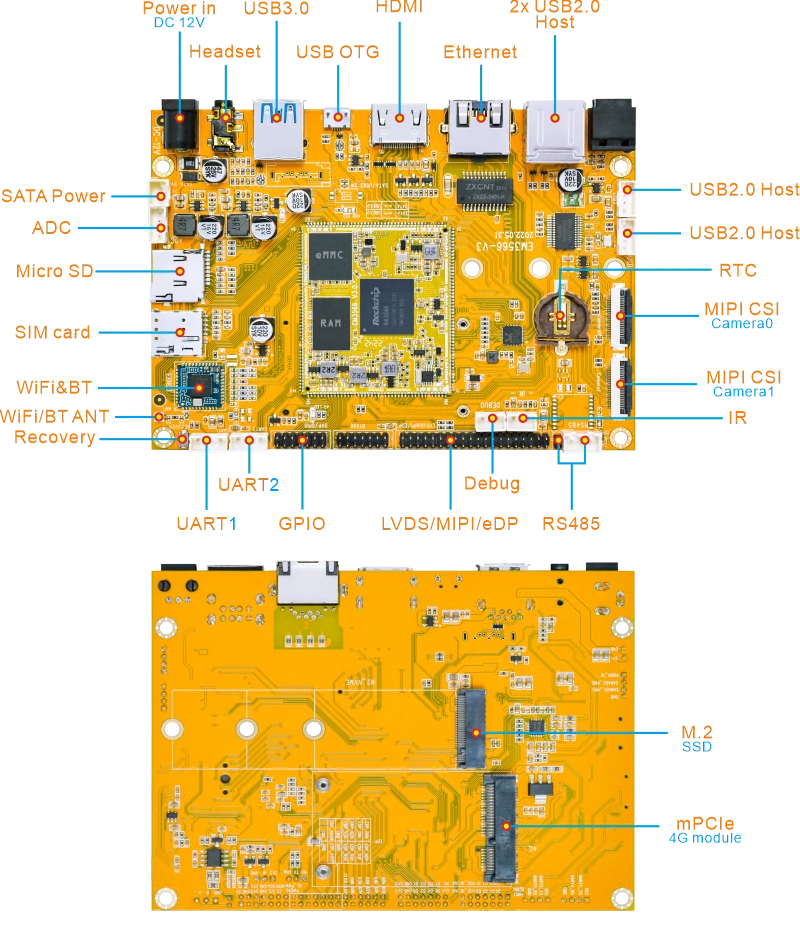
| Specifications | |
|---|---|
| SoC | RockChip RK3566 quad-core Cortex-A55 @ up to 1.8GHz |
| NPU | 1 TOPS NPU |
| GPU | ARM Mali-G52 2EE GPU with support for OpenGL ES 1.1/2.0/3.2. OpenCL 2.0. Vulkan 1.1 |
| Memory | 2GB (up to 8GB) |
| Storage | 8GB eMMC flash (up to 128GB) M.2 PCIe 2.0 socket Micro SD card slot |
| Power Supply | 12V/3A DC input jack |
| USB | 1x USB OTG 2.0 4x USB Host 2.0 (USB-AF or 4-pin connector) 1x USB 3.0 |
| Connectivity | Gigabit Ethernet RJ45 port via Realtek RTL8211F-CG controller 2.4G WiFi(802.11b/g/n) with Bluetooth 4.2 mPCIe socket with Nano SIM card port to support 4G&GPS module |
| Serial | 1x Serial port for debug, 3-pin connector 2x UART, 4-pin connector 1x RS485, 2-pin header or 3-pin connector |
| Video | HDMI 2.0, 4Kp60 MIPI DSI/LVDS, 1080p60 eDP 1.3, 2560x1600@60Hz |
| Audio | 3.5mm audio I/O jack. ES8388 audio codec 8-channel audio via HDMI |
| Camera(optional) | 2x Cameras via MIPI CSI (24pin FPC connector) |
| Keys & Switch | 1x Recover Key |
| Other features | RTC with battery connector, IR receiver, GPIO, ADC |
| Dimensions | 135 x 95 mm |

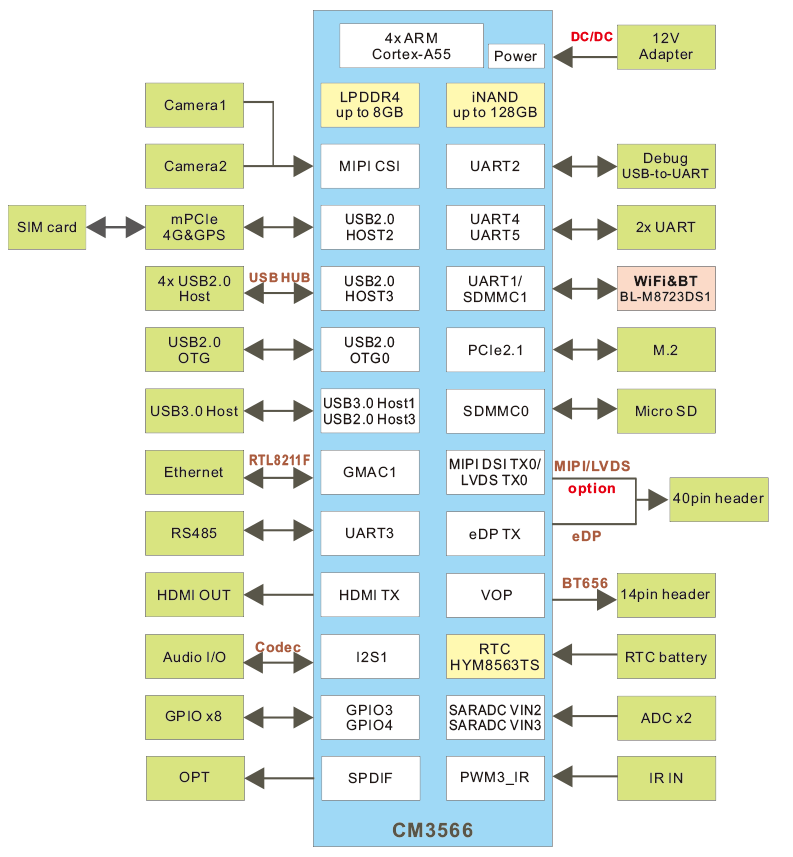

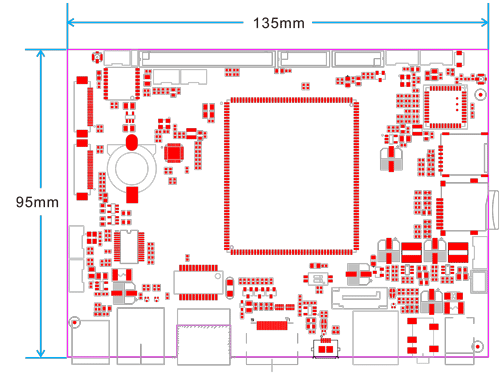
| OS | Item | Feature | Description |
|---|---|---|---|
| Android 14 | Boot | U-Boot 2017.09 | rk356x_spl_loader_v1.23.114.bin |
| Kernel | Version | Linux 6.1.99 | |
| Drivers | eMMC | Support eMMC 5.1 | |
| HDMI | Support 4K, 1080P, 720P, 480P resolution | ||
| Audio | Headphone input/ output | ||
| SD card | Micro SD card | ||
| USB Host | 4x USB2.0 Host | ||
| USB3.0 | USB3.0 Host/SATA3.0 | ||
| Key | Recovery | ||
| USB OTG | USB2.0 OTG | ||
| Ethernet | 10/100/1000 Mbps Ethernet | ||
| Camera | 13 Megapixels, OV13850 model | ||
| WiFi | Wireless-2.4GHz 802.11 b/g/n | ||
| Bluetooth | Bluetooth 4.2 | ||
| 4G&GPS | EC20 LTE | ||
| LCD&TP | 10.1-inch LVDS/MIPI LCD with touch screen | ||
| RTC | HYM8563TS | ||
| Serial port | 2x UART, 1x debug | ||
| RS485 | Support | ||
| Cross-compiler Environment | Ubuntu 22.04/openjdk 11.0.4 | ||
| Debug Tools | SecureCRT, AndroidTool.exe, ADB | ||
| OS | Item | Feature | Description |
|---|---|---|---|
| Debian 12 Buildroot (Linux 6.1) |
Boot | U-Boot 2017.09 | rk356x_spl_loader_v1.23.114.bin |
| Kernel | Version | Linux 6.1.99 | |
| Drivers | eMMC | Support eMMC 5.1 | |
| HDMI | Support 4K, 1080P, 720P, 480P resolution | ||
| Audio | Headphone input/ output | ||
| SD card | Micro SD card | ||
| USB Host | 4x USB2.0 Host | ||
| USB3.0 | USB3.0 Host/SATA3.0 | ||
| Key | Recovery | ||
| USB OTG | USB2.0 OTG | ||
| Ethernet | 10/100/1000 Mbps Ethernet | ||
| Camera | 13 Megapixels, OV13850 model | ||
| WiFi | Wireless-2.4GHz 802.11 b/g/n | ||
| Bluetooth | Bluetooth 4.2 | ||
| 4G&GPS | EC20 LTE | ||
| LCD&TP | 10.1-inch LVDS LCD with touch screen | ||
| RTC | HYM8563TS | ||
| Serial port | 2x UART, 1x debug | ||
| RS485 | Support | ||
| Cross-compiler Environment | Ubuntu 22.04 | ||
| Debug Tools | SecureCRT, AndroidTool.exe, ADB | ||
| OS | Item | Feature | Description |
|---|---|---|---|
| Debian 11 Buildroot (Linux 5.10) |
Boot | U-Boot 2017.09 | rk3566_ddr_1056MHz_v1.17.bin |
| Kernel | Version | Linux 5.10.160 | |
| Drivers | eMMC | Support eMMC 5.1 | |
| HDMI | Support 4K, 1080P, 720P, 480P resolution | ||
| Audio | Headphone input/ output | ||
| SD card | Micro SD card | ||
| USB Host | 4x USB2.0 Host | ||
| USB3.0 | USB3.0 Host/SATA3.0 | ||
| Key | Recovery | ||
| USB OTG | USB2.0 OTG | ||
| Ethernet | 10/100/1000 Mbps Ethernet | ||
| Camera | 13 Megapixels, OV13850 model | ||
| WiFi | Wireless-2.4GHz 802.11 b/g/n | ||
| Bluetooth | Bluetooth 4.2 | ||
| 4G&GPS | EC20 LTE | ||
| LCD&TP | 7-inch/10.1-inch LVDS LCD with touch screen | ||
| RTC | HYM8563TS | ||
| Serial port | 2x UART, 1x debug | ||
| RS485 | Support | ||
| Cross-compiler Environment | Ubuntu 20.04 | ||
| Debug Tools | SecureCRT, AndroidTool.exe, ADB | ||
| Datasheet |
|
|
|
|
|
|
| Reference Manual |
|
|
| Tools |
|
|
| Expansion Module | Module Detail | Android | Debian | Buildroot |
|---|---|---|---|---|
 4G&GPS 4G&GPS |
Quectel EC20 Mini PCIe Multi-mode LTE Module | √ | √ | √ |
 WiFi&Bluetooth WiFi&Bluetooth |
BL-M8723DS1 module. 2.4G WiFi + Bluetooth 4.2 | √ | √ | √ |
 Camera Camera |
OV13850 module, 13-Megapixel | √ | √ | √ |
 7-inch LVDS LCD 7-inch LVDS LCD |
7-inch Capacitive Touch Screen, 1024 x 600 | √ | √ | √ |
 10.1-inch LVDS LCD 10.1-inch LVDS LCD |
10.1-inch Capacitive Touch Screen, 1280 x 800 | √ | √ | √ |
 10.1-inch MIPI LCD 10.1-inch MIPI LCD |
10.1-inch Capacitive Touch Screen, 1280 x 800 | √ | √ | √ |
1. Execute the commands to reconfig the kernel
# cd kernel
# make ARCH=arm64 menuconfig
2. After reconfig, rename the file kernel\.config to rockchip_linux_defconfig
3. Copy the file kernel\rockchip_linux_defconfig to replace kernel\arch\arm64\configs\rockchip_linux_defconfig
It is recommended to back up the original rockchip_linux_defconfig before replacing.
eg. Switch HDMI to MIPI LCD (Debian11)
Config files path: k356x_linux5.10\kernel\arch\arm64\boot\dts\rockchip\
1. open the file rk3566-evb2-lp4x-v10-linux.dts with an editor. Comment HDMI, uncomment MIPI and save:
//#include "rk3566-evb2-lp4x-v10_hdmi.dtsi"
#include "rk3566-evb2-lp4x-v10_mipi.dtsi"
2. recompile kernel
3. reflash kernel to the board.
I downloaded the source code,when I try to compile, I got this error:
@ubuntu:~/rk356x_linux5.10$ ./build.sh kernel
processing option: kernel
============Start building kernel============
TARGET_ARCH =arm64 TARGET_KERNEL_CONFIG =rockchip_linux_defconfig TARGET_KERNEL_DTS =rk3566-evb2-lp4x-v10-linux TARGET_KERNEL_CONFIG_FRAGMENT =
==========================================
# # No change to .config # CALL scripts/atomic/check-atomics.sh CALL scripts/checksyscalls.sh CHK include/generated/compile.h LZ4C arch/arm64/boot/Image.lz4
Incorrect parameters Usage : lz4 [arg] [input] [output] input : a filename with no FILE, or when FILE is - or stdin, read standard input
Arguments :
-1 : Fast compression (default) -9 : High compression -d : decompression (default for .lz4 extension) -z : force compression -f : overwrite output without prompting -h/-H : display help/long help and exit arch/arm64/boot/Makefile:31: recipe for target 'arch/arm64/boot/Image.lz4' failed make[2]: *** [arch/arm64/boot/Image.lz4] Error 1 make[2]: *** Deleting file 'arch/arm64/boot/Image.lz4' arch/arm64/Makefile:170: recipe for target 'Image.lz4' failed make[1]: *** [Image.lz4] Error 2 make[1]: *** Waiting for unfinished jobs.... arch/arm64/Makefile:214: recipe for target 'rk3566-evb2-lp4x-v10-linux.img' failed make: *** [rk3566-evb2-lp4x-v10-linux.img] Error 2 ERROR: Running build_kernel failed! ERROR: exit code 2 from line 663: make ARCH=$RK_ARCH $RK_KERNEL_DTS.img -j$RK_JOBS
Cause: The version of lz4 delivered with the compilation system is too early.
Solution: update to V1.8.3 or later.
lz4 -v //check the compiler lz4 version
sudo cp out/host/linux-x86/bin/lz4 /usr/bin/lz //copy lz4 from the Android source directory to override the compiler's
Camera does not work properly on board with more than 4GB of memory. After the memory is upgraded from 4GB to 8GB, open the camera APP, the terminal will output:
[ 100.488782] rga_mm: RGA_MMU unsupported Memory larger than 4G! [ 100.488814] rga_mm: scheduler core[4] unsupported mm_flag[0x0]! [ 100.488821] rga_mm: rga_mm_map_buffer map dma_buf error! [ 100.488826] rga_mm: job buffer map failed! [ 100.488831] rga_mm: dst channel map job buffer failed! [ 100.488834] rga_mm: failed to map buffer [ 100.488842] rga_job: rga_job_commit: failed to map job info [ 100.488896] rga_job: request[1] task[0] job_commit failed. [ 100.488909] rga_job: rga request commit failed! [ 100.488915] rga: request[1] submit failed!
Solution: Modify the source code according to the file ddr_than-4G.patch and compile it again.
upgrade_tool is a firmware upgrade tool for Linux. Flash image requires superuser privileges.
1. Download and execute upgrade_tool first.
2. Put the firmware files and upgrade_tool in the same directory.
3. Connect the USB OTG port from the board to your PC, press the recovery button from your board, and connect the power, wait a few seconds and release the button.
4. Use the commands to flash image.
Basic Commands
//List devices upgrade_tool ld //Download boot upgrade_tool db rkxxloader.bin //Flash the partition table upgrade_tool di -p parameter.txt //Flash single partition image upgrade_tool di -k kernel.img //Falsh multiple partition images upgrade_tool di -u uboot.img -b boot.img //Flash the partition image with no defined abbreviation, you need to specify the partition name. //Take the vendor partition as an example upgrade_tool di -vendor vendor.img //When ab partition are used, it also needs to be handled in undefined cases. //Take boot_a and boot_b as example upgrade_tool di -boot_a boot.img -boot_b boot.img //Flash loader and reset upgrade_tool ul rkxxloader.bin //Upgrade firmware and reset upgrade_tool uf update.img //Erase device upgrade_tool ef rkxxloader.bin
